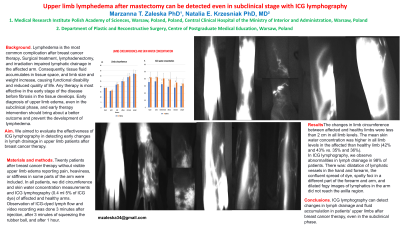Clinical Research
(CR-065) Upper limb lymphedema after mastectomy can be detected even in subclinical stage with ICG lymphography.
Friday, April 28, 2023
7:15 PM - 8:30 PM East Coast USA Time

Natalia Krzesniak, PhD
Introduction: Lymphedema is the most commoncomplication after breast cancer therapy. Surgical treatment, lymphadenectomy, and irradiation impaired lymphatic drainage in the affected arm. Consequently, tissue fluid accumulates in tissue space, and limb size and weight increase, causing functional disability and reduced quality of life. Any therapy is most effective in the early stage of the disease before fibrosis in the tissue develops. Early diagnosis of upper limb edema, even in the subclinical phase, and early therapy intervention should bring about a better outcome and prevent the development of lymphedema.
Aim. We aimed to evaluatethe effectiveness of ICG lymphography in detecting early changes in lymph drainage in upper limb patients after breast cancer therapy.
Methods: Twenty patients after breast cancer therapy without visible upper limb edema reporting pain, heaviness, or stiffness in some parts of the arm were included. In all patients, we did circumference and skin water concentration measurements and ICG lymphography (0.4 ml 5% of ICG dye) of affected and healthy arms. Observation of ICG-dyed lymph flow and video recording was done 3 minutes after injection, after 3 minutes of squeezing the rubber ball, and after 1 hour.
Results: The changes in limb circumference between affected and healthy limbs were less than 2 cm in all limb levels. The mean skin water concentration was higher in all limb levels in the affected than healthy limb, with the highest water accumulation in the hand and forearm (42% and 43% vs. 35% and 36%).
In ICG lymphography, we observe abnormalities in lymph drainage in 98% of patients. There was: dilatation of lymphatic vessels in the hand and forearm, the confluent spread of dye, spotty foci in a different part of the forearm and arm, and dilated fogy images of lymphatics in the arm did not reach the axilla region.
Discussion: ICG lymphography can detect changes in lymph drainage and fluid accumulation in patients' upper limbs after breast cancer therapy, even in the subclinical phase. Early initiation of conservative or surgical (LVA) intervention can prevent the development of advanced lymphedema and its complications and improve breast cancer survivors' quality of life.
Aim. We aimed to evaluatethe effectiveness of ICG lymphography in detecting early changes in lymph drainage in upper limb patients after breast cancer therapy.
Methods: Twenty patients after breast cancer therapy without visible upper limb edema reporting pain, heaviness, or stiffness in some parts of the arm were included. In all patients, we did circumference and skin water concentration measurements and ICG lymphography (0.4 ml 5% of ICG dye) of affected and healthy arms. Observation of ICG-dyed lymph flow and video recording was done 3 minutes after injection, after 3 minutes of squeezing the rubber ball, and after 1 hour.
Results: The changes in limb circumference between affected and healthy limbs were less than 2 cm in all limb levels. The mean skin water concentration was higher in all limb levels in the affected than healthy limb, with the highest water accumulation in the hand and forearm (42% and 43% vs. 35% and 36%).
In ICG lymphography, we observe abnormalities in lymph drainage in 98% of patients. There was: dilatation of lymphatic vessels in the hand and forearm, the confluent spread of dye, spotty foci in a different part of the forearm and arm, and dilated fogy images of lymphatics in the arm did not reach the axilla region.
Discussion: ICG lymphography can detect changes in lymph drainage and fluid accumulation in patients' upper limbs after breast cancer therapy, even in the subclinical phase. Early initiation of conservative or surgical (LVA) intervention can prevent the development of advanced lymphedema and its complications and improve breast cancer survivors' quality of life.

.png)